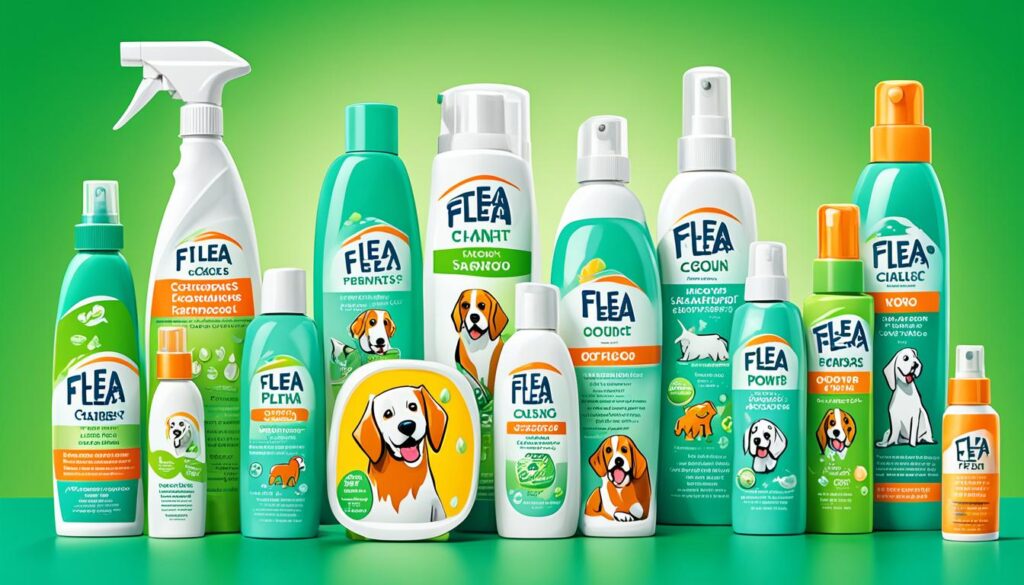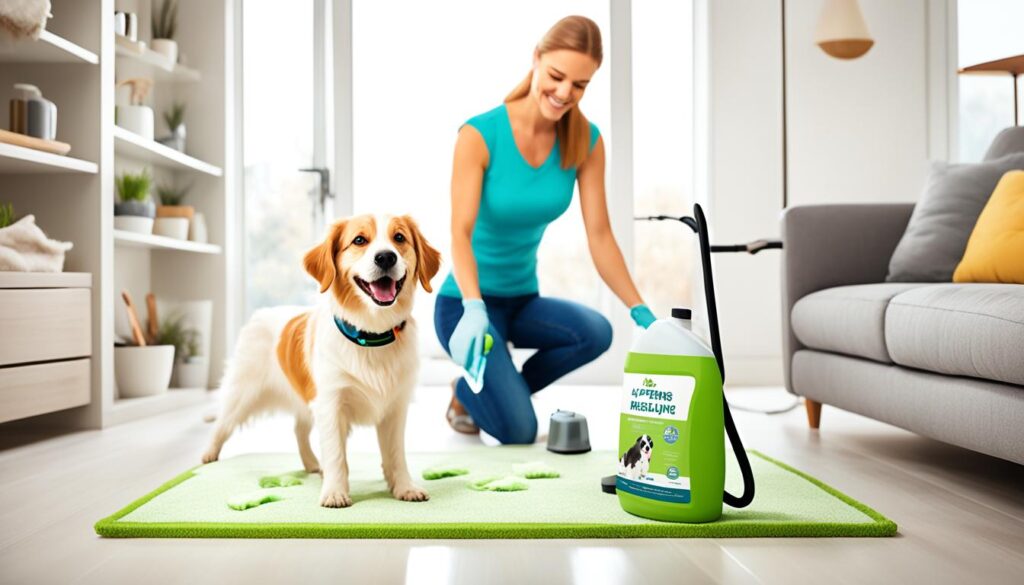Flea-Free Fidos: Preventing Parasites
Did you know that fleas can lay up to 50 eggs per day? That’s a staggering number, considering that a single flea can quickly multiply into a full-blown infestation, posing a serious threat to the health and well-being of your beloved canine companion. Preventing parasite infestations is crucial for the overall well-being of your furry friend, and in this article, we will discuss effective strategies for parasite prevention for dogs.
Key Takeaways:
- Parasites can cause discomfort and transmit diseases to dogs.
- Both fleas and ticks can pose serious health risks to dogs.
- Choosing the right parasite prevention products is essential.
- Creating a routine for parasite prevention helps ensure optimal protection.
- Regular check-ups and grooming practices contribute to effective parasite control.
Understanding Parasites and Their Dangers
Parasites such as fleas, ticks, and lice can pose multiple health risks to dogs. Not only do these parasites cause discomfort and irritation, but they can also transmit various diseases. It’s crucial to be aware of the types of parasites that can affect your furry friend and the potential health implications they bring.
Flea-borne diseases are a significant concern for dogs. One common example is flea allergy dermatitis, which can lead to severe itching, inflammation, and secondary infections. Another flea-borne disease is Bartonella infection, also known as “cat scratch disease,” which can cause fever, vomiting, and swollen lymph nodes.
Ticks are notorious for transmitting dangerous diseases to dogs through their bites. Lyme disease is a prominent tick-borne disease that can result in joint pain, fever, and fatigue. Rocky Mountain spotted fever is another tick-borne illness that can cause symptoms such as fever, muscle pain, and rash.
Image:
Understanding these risks is vital for pet owners to take proactive measures in preventing parasite infestations. By implementing effective parasite prevention strategies, you can safeguard your dog’s health and well-being.
Flea Prevention for Dogs
Fleas are a common nuisance for dogs, but there are several effective methods of flea prevention that can help keep your furry friend itch-free and comfortable. Let’s explore some of the most popular flea prevention products and treatments available for dogs:
1. Topical Treatments
Topical treatments, also known as spot-on treatments, are applied directly to the dog’s skin and provide long-lasting protection against fleas. These treatments usually come in small tubes and are applied between the dog’s shoulder blades or along the back. The active ingredients in topical treatments kill adult fleas, prevent egg development, and break the flea life cycle. They are easy to use and provide ongoing protection for several weeks.
2. Oral Medications
Oral medications are another effective option for flea prevention. These medications are usually chewable tablets or pills that are given to dogs once a month. The active ingredients in oral medications are absorbed into the bloodstream and kill fleas when they bite your dog. In addition to killing adult fleas, some oral medications also prevent heartworm disease and treat other internal parasitic infections.
3. Flea Collars
Flea collars are another popular choice for flea prevention. These collars are infused with chemicals that repel and kill fleas. They provide continuous protection against fleas and are easy to use. Simply place the collar around your dog’s neck, and it will release the active ingredients that repel and kill fleas. Flea collars are a convenient option for dogs who don’t tolerate topical treatments or oral medications well.
It’s important to choose the right flea prevention product for your dog’s specific needs. Factors such as your dog’s age, weight, breed, and any underlying health conditions should be considered when selecting a flea prevention method. It’s always best to consult with your veterinarian, who can recommend the most suitable flea prevention product for your dog.
Flea prevention products are an essential part of keeping your dog free from fleas and the discomfort they cause. Consistency in using these products and following the recommended application schedule is key to ensuring their effectiveness.
In addition to using flea prevention products, it’s important to practice good hygiene and regularly groom your dog to minimize the risk of flea infestations. Regularly washing your dog’s bedding, vacuuming your home, and maintaining a clean living environment can also help prevent fleas from multiplying.

| Flea Prevention Method | Pros | Cons |
|---|---|---|
| Topical Treatments | Easy to use | May cause skin irritation in some dogs |
| Oral Medications | Provide systemic protection | May not be suitable for dogs with certain health conditions |
| Flea Collars | Continuous protection | May have an odor or be bulky |
Remember, flea prevention is an important aspect of your dog’s overall health and well-being. By using the right flea prevention products and following a regular flea prevention routine, you can help keep your dog flea-free and happy.
Tick Prevention for Dogs
Ticks can pose a serious threat to the health of dogs, as they are capable of transmitting dangerous diseases. Therefore, tick prevention is essential to keep our furry friends safe and healthy. There are several effective tick prevention products available that can help protect dogs from these harmful parasites.
Tick Repellents: Tick repellents are specially formulated products designed to repel ticks. These products often contain active ingredients such as fipronil or permethrin, which are effective in repelling ticks and preventing them from attaching to the dog’s skin. Tick repellents come in various forms, such as sprays, wipes, and spot-on treatments, allowing for convenient and easy application.
Tick Collars: Tick collars are another popular tick prevention option. These collars contain active ingredients that are slowly released onto the dog’s skin, providing continuous protection against ticks. They are an effective choice for dogs that spend a lot of time outdoors in tick-infested areas.
In addition to using tick prevention products, it is crucial to perform regular tick checks on your dog. After walks in wooded areas or tall grasses where ticks are commonly found, carefully examine your dog’s coat, paying close attention to areas such as the ears, neck, and between the toes. Removing ticks promptly reduces the risk of disease transmission.
Vaccination against tick-borne diseases is another essential aspect of tick prevention for dogs. Vaccines are available for diseases such as Lyme disease, which can be transmitted through tick bites. Consult with your veterinarian to determine if vaccination is recommended based on your dog’s lifestyle and geographical location.
| Tick Prevention Products | Advantages | Disadvantages |
|---|---|---|
| Tick Repellents | – Easy to apply – Various application options (sprays, wipes, spot-on) |
– Requires regular reapplication – May have a strong odor |
| Tick Collars | – Continuous protection – Suitable for outdoor dogs |
– May cause skin irritation in some dogs – Not recommended for dogs that swim regularly |
By combining the use of tick prevention products, regular tick checks, and appropriate vaccination, you can create a comprehensive tick prevention plan for your dog. Working closely with your veterinarian will ensure that you select the right products and take the necessary precautions to keep your dog protected from tick-borne diseases.
Quote:
“Tick prevention is crucial to safeguarding the health and well-being of dogs. By implementing preventive measures and using effective tick prevention products, dog owners can significantly reduce the risk of tick-borne diseases and ensure a healthier and happier life for their pets.” – Dr. Emily Johnson, DVM
Other Parasite Prevention Measures
In addition to flea and tick prevention, there are other measures you can take to prevent parasite infestations in your dog. Regular grooming, environmental control, regular check-ups, and proper hygiene practices are all important aspects of a comprehensive parasite prevention plan.
Grooming:
Regular grooming is essential for maintaining your dog’s overall health and preventing parasites. By bathing your dog regularly and brushing their coat, you can remove any potential parasites and keep their skin and fur clean and healthy.
Environmental Control:
Keeping your dog’s living environment clean is important for preventing parasite infestations. Regularly cleaning your dog’s bedding, vacuuming the house, and removing any debris or standing water in the yard can help eliminate potential breeding grounds for parasites.
Regular Check-ups:
Scheduling regular check-ups with your veterinarian is crucial for identifying and treating any potential parasite issues. During these check-ups, your veterinarian can perform thorough examinations and recommend appropriate preventive measures based on your dog’s specific needs.
Proper Hygiene:
Maintaining proper hygiene practices for your dog can further reduce the risk of parasite infestations. This includes keeping their living area clean, washing their toys regularly, and ensuring that their food and water bowls are clean and sanitized.
| Grooming Tips | Environmental Control Measures |
|---|---|
|
|
By incorporating these parasite prevention measures into your dog’s routine, you can help ensure their optimal health and well-being. Remember to consult with your veterinarian for further guidance and recommendations specific to your dog’s needs.

Choosing the Right Parasite Prevention Products
When it comes to protecting your dog from parasites, choosing the right prevention products is crucial. You want to ensure their effectiveness, safety, and suitability for your dog’s specific breed and size. Consulting with your veterinarian for recommendations is essential as they can provide valuable insights based on their expertise and knowledge of your dog’s individual needs.
Vet-recommended products are often the most reliable and effective in preventing parasite infestations. These products have been tested and proven to work, giving you peace of mind that you are providing your dog with the best protection possible. Your veterinarian can recommend specific brands and products that have a track record of success.
One size does not fit all when it comes to parasite prevention. Different breeds and sizes of dogs may require different products or formulations. Some products may be too strong for small or sensitive breeds, while others may not provide adequate protection for larger breeds. Your veterinarian can help determine the most suitable options for your dog, taking into account their unique characteristics and individual needs.
Effectiveness and Safety
When evaluating parasite prevention products, two crucial factors to consider are their effectiveness and safety. You want a product that not only repels and kills parasites but also does so consistently and for an extended period. Look for products that have been proven to provide long-lasting protection against fleas, ticks, and other parasites.
Safety is paramount when it comes to choosing parasite prevention products for your dog. Ensure that the products you select have undergone rigorous testing and have been approved for use in dogs. Avoid products that contain potentially harmful ingredients or have a history of adverse reactions. Your veterinarian can guide you towards safe and effective options.
Remember to always follow the manufacturer’s instructions and dosage guidelines when using parasite prevention products. Applying too much or too little can diminish their effectiveness or even pose a risk to your dog’s health.
Consulting with Your Veterinarian
Your veterinarian is your best resource when it comes to choosing the right parasite prevention products for your dog. They have extensive knowledge of the different options available and can provide personalized recommendations based on your dog’s specific needs.
During your consultation, be sure to provide detailed information about your dog, including their breed, size, age, and any existing health conditions. This information will help your veterinarian make informed decisions about which products will be most effective and safe for your furry friend.
By working closely with your veterinarian and selecting the appropriate parasite prevention products, you can ensure that your dog stays protected from fleas, ticks, and other parasites that can jeopardize their health and well-being.
https://www.youtube.com/watch?v=sntxKcU8Tic
Creating a Parasite Prevention Routine
To ensure the effectiveness of parasite prevention measures, it is important to establish a routine. Consistent use and regular application of flea and tick prevention products are crucial for optimal protection against these harmful parasites.
One way to stay on track with the recommended application schedule is to set reminders or use calendar alerts. This will help you remember when it’s time to reapply flea and tick prevention treatments, ensuring that your dog remains protected.
However, parasite prevention shouldn’t stop at just using products. It’s also important to integrate these measures with other routine healthcare practices for your dog. For example, regular annual vaccinations and wellness check-ups can complement your parasite prevention routine and provide comprehensive health protection.
By combining parasite prevention with other routine healthcare measures, you create a proactive healthcare plan that promotes your dog’s overall well-being. This integration ensures that your furry friend receives comprehensive care and protection against parasites and other potential health issues.
The Benefits of a Parasite Prevention Routine:
- Protects your dog from flea and tick infestations
- Helps prevent the transmission of flea-borne and tick-borne diseases
- Ensures consistent protection by applying treatments on time
- Creates a comprehensive healthcare plan for your dog
Remember, consistent use, regular application, and integration with other routine healthcare measures are key to effective parasite prevention. By following a well-established routine, you can keep your dog happy, healthy, and free from parasites.
| Consistent Use | Regular Application | Integration with Routine Healthcare Measures |
|---|---|---|
| Apply flea and tick prevention products according to the recommended schedule | Reapply treatments as instructed to maintain continuous protection | Combine parasite prevention with annual vaccinations and wellness check-ups |
| Ensure your dog is consistently protected against fleas and ticks | Maintain a regular application routine to prevent infestations | Create a comprehensive healthcare plan for your dog’s overall well-being |

Conclusion
Parasite prevention is crucial for maintaining the optimal health and well-being of dogs. By implementing effective measures such as regular use of flea and tick prevention products, practicing proper grooming and hygiene, and working closely with your veterinarian, you can ensure that your furry friend remains flea-free and protected from harmful parasites.
Preventing parasites not only keeps your dog comfortable but also helps prevent the transmission of diseases that can have serious health implications. A flea-free and tick-free lifestyle is essential for a healthy and happy dog.
Remember to choose the right parasite prevention products based on your dog’s specific needs and consult with your veterinarian for recommendations. By maintaining a consistent routine and integrating parasite prevention measures into your dog’s overall healthcare plan, you can provide the best protection against parasites and promote their optimal health.
FAQ
Why is parasite prevention important for dogs?
Parasites can pose a serious threat to the health and well-being of dogs. Preventing parasite infestations is crucial for the overall well-being of your furry friend.
What are the different types of parasites that can affect dogs?
Parasites that commonly affect dogs include fleas, ticks, and lice.
What are the health risks associated with flea and tick infestations?
Flea-borne diseases such as flea allergy dermatitis and Bartonella infection, as well as tick-borne diseases like Lyme disease and Rocky Mountain spotted fever, can have serious health implications for dogs.
How can I prevent flea infestations in my dog?
There are several effective methods of flea prevention, including topical treatments, oral medications, and flea collars. It is important to choose the right product based on your dog’s specific needs and consult with your veterinarian for recommendations.
How can I prevent tick infestations in my dog?
Tick prevention products such as repellents and collars can be used to keep ticks at bay. Regular tick checks should also be performed, especially after walks in wooded areas or tall grasses. Vaccination against tick-borne diseases can provide additional protection.
What other measures can I take to prevent parasite infestations in my dog?
Regular grooming, including bathing and brushing, can help remove potential parasites from your dog’s coat. Environmental control, such as regularly cleaning bedding and vacuuming the house, can also help eliminate parasites. Regular check-ups with a veterinarian are crucial for identifying and treating any potential parasite issues. Maintaining proper hygiene practices for your dog, such as keeping their living area clean and washing their toys regularly, can further reduce the risk of parasite infestations.
How do I choose the right parasite prevention products for my dog?
When selecting parasite prevention products, it is important to consider their effectiveness, safety, and suitability for specific breeds and sizes. Consult with your veterinarian for recommendations, as vet-recommended products are often the most reliable and effective in preventing parasite infestations.
How can I create a parasite prevention routine for my dog?
Consistent use of flea and tick prevention products, such as regular application of topical treatments or administration of oral medications, is crucial for optimal protection. Setting reminders or using calendar alerts can help you stay on track. Integrating parasite prevention measures with other routine healthcare measures for your dog, such as annual vaccinations and regular wellness check-ups, can help create a comprehensive and proactive healthcare plan.
Why is parasite prevention important for optimal health and well-being?
Preventing parasites is essential for the overall health and well-being of dogs. By implementing effective parasite prevention measures, you can ensure that your furry friend remains flea-free and protected from harmful parasites.


